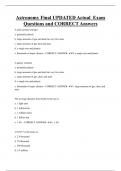Astronomy Final UPDATED Actual Exam
Questions and CORRECT Answers
A solar system contains
a. primarily planets
b. large amounts of gas and dust but very few stars
c. large amounts of gas dust and stars
d. a single star and planets
e. thousands of super clusters - CORRECT ANSWER- ✔✔d. a single star and planets
A galaxy contains
a. primarily planets
b. large amounts of gas and dust but very few stars
c. large amounts of gas, dust, and stars
d. a single star and planets
e. thousands of super clusters - CORRECT ANSWER- ✔✔c. large amounts of gas, dust, and
stars
The average distance from Earth to the sun is
a. 1 light year
b. 1 million km
c. 1 million miles
d. 1 billion km
e. 1 AU - CORRECT ANSWER- ✔✔e. 1 AU
2.9x10^7 is the same as
a. 2.9 thousand
b. 29 thousand
c. 290 thousand
d. 2.9 million
,e. 29 million - CORRECT ANSWER- ✔✔e. 29 million
64,200,000,000 is equal to
a. 6.42x10^7
b. 6.42x10^-7
c. 6.42x10^10
d. 6.42x10^-10
e. 1.0x10^64.2 - CORRECT ANSWER- ✔✔c. 6.42x10^10
3.0x10^5 times 1.5x10^9 is equal to
a. 4.5x10^45
b. 4.5x10^14
c. 2.0x10^4
d. 2.0x10^14
e. 2.0x10^45 - CORRECT ANSWER- ✔✔b. 4.5x10^14
4.4x10^6 divided by 8.8x10^10 is equal to
a. 5.0x10^-5
b. 5.0x10^-4
c. 5.0x10^4
d. 3.9x10^17
e. 3.9x10^16 - CORRECT ANSWER- ✔✔a. 5.0x10^-5
If light takes 8 minutes to reach Earth from the sun and 5.3 hours to reach Pluto, what is the
approximate distance from the sun to Pluto?
a. 5.3 AU
b. 40 AU
c. 40 light year
d. 5.3 light years
e. 0.6 light years - CORRECT ANSWER- ✔✔b. 40 AU
,The sun is
a. a star
b. 1 AU form Earth
c. more than 100 times the diameter of Earth
d. all of the above
e. none of the above - CORRECT ANSWER- ✔✔d. all of the above
If the nearest star is 4.2 billion light years away, then
a. the star is 4.2 million AU away
b. the light we see left the star 4.2 years ago
c. the star must have formed 4.2 billion years ago
d. the star must be very young
e. the star must be very old - CORRECT ANSWER- ✔✔b. the light we see left the star 4.2
years ago
The Milky Way Galaxy
a. contains about 100 stars
b. is the largest unknown object in the universe
c. is about 75,000 light years in diameter
d. is located about 2.2 million light years from the sun
e. only a and c are correct - CORRECT ANSWER- ✔✔c. is about 75,000 light years in
diameter
Which of the following is the largest?
a. the diameter of Earth
b. the diameter of the moon
c. the diameter of the sun
d. the diameter of Jupiter
e. the distance from Earth to the sun - CORRECT ANSWER- ✔✔e. the distance from Earth
to the sun
, Which arrangement is in order of increasing size, left to right?
a. planet, galaxy, star, solar system
b. planet, star, galaxy, solar system
c. planet, star, solar system, galaxy
d. solar system, galaxy, star, planet - CORRECT ANSWER- ✔✔c. planet, star, solar system,
galaxy
If the Earth were represented as a basketball (~10 in.) and the Moon as a baseball (~3 in.)
then, to order of magnitude, what size would best represent the diameter of the sun?
a. 10 ft.
b. 100 ft.
c. 1000 ft.
d. 10,000 ft. - CORRECT ANSWER- ✔✔b. 100 ft.
Which sequence is correct when ordered by increasing size?
a. Earth, solar system, Milky Way, galaxy clusters
b. solar system, Earth, galaxy clusters, Milky Way
c. Earth, Milky Way, solar system, galaxy clusters
d. galaxy clusters, solar system, Milky Way, Earth - CORRECT ANSWER- ✔✔a. Earth,
solar system, Milky Way, galaxy clusters
How is a planet different than a star?
a. planets are larger than stars
b. planets reflect light while stars produce their own light
c. stars move faster in the sky than planets
d. planets are brighter than stars - CORRECT ANSWER- ✔✔b. planets reflect light while
stars produce their own light
If we say that an object is 1,000 light years away we see it
a. as it looked 1,000 years ago





